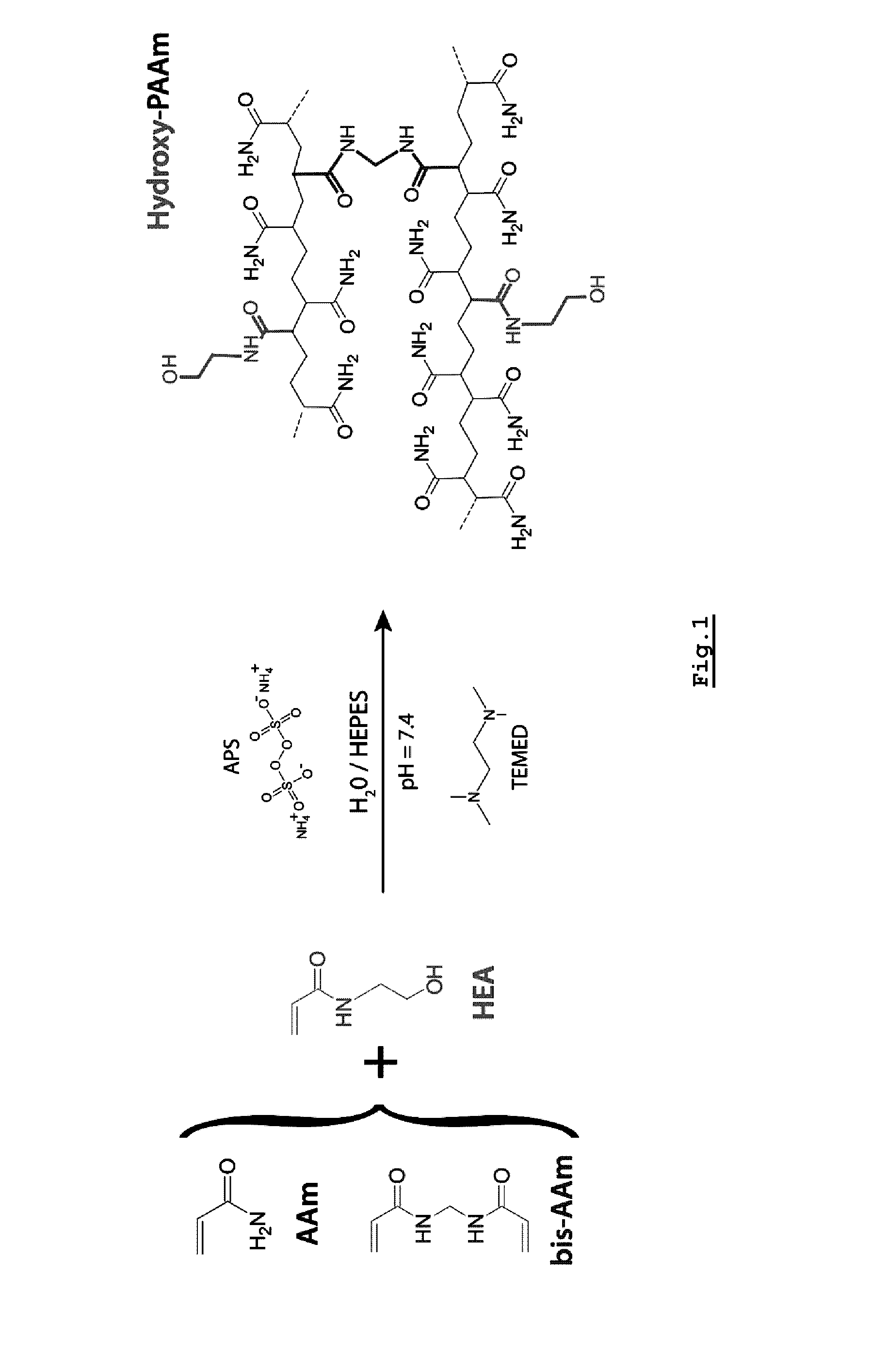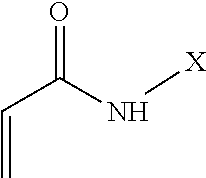Micro-engineered hydrogels
a technology of polyacrylamide and hydrogel, which is applied in the field of micro-engineered hydrogels, can solve the problems of requiring technical facilities, unable to provide an accurate model for cell biology assays and especially cellular mechanosensing, and unable to accurately characterize the structure of the cell,
- Summary
- Abstract
- Description
- Claims
- Application Information
AI Technical Summary
Benefits of technology
Problems solved by technology
Method used
Image
Examples
example 1
Synthesis of Hydroxy-PAAm Hydrogels
[0077]Hydroxy-PAAm hydrogels were synthetized on a glass surface for the convenience of operating cell adhesion experiments. Circular glass coverslips of 25 mm in diameter were cleaned with 0.1 M NaOH (Sigma, Saint-Louis, Mo.) solution during 5 minutes and then rinsed abundantly (20 minutes under agitation) with deionized water. Cleaned coverslips were treated during one hour with 3-(Trimethoxysilyl)propyl acrylate (Sigma, Saint-Louis, Mo.) to promote strong adhesion between hydroxy-PAAm gel and glass and dried under a nitrogen flow. In a 15 mL Eppendorf tube, 500 μL acrylamide 40% w / w in HEPES (AAm, Sigma, Belgium), 250 to 1250 μL N,N′-methylenebisacrylamide 2% w / w in HEPES (BisAAm, Sigma, Saint-Louis, Mo.) and 1065 μL N-hydroxyethylacrylamide monomers (65 μg / mL in HEPES, Sigma, Saint-Louis, Mo.) were mixed and the desired volume of a solution of 4-(2-hydroxyethyl)-1-piperazineethanesulfonic acid 50 mM (HEPES, Sigma, Saint-Louis, Mo.) was added to...
example 2
Polydimethylsiloxane Stamps
[0078]Micropatterns of different shapes (lines, circles, triangles, squares and rectangles of aspect ratios 1:2, 1:4 and 1:10), and various areas (1200-2500 μm2) were designed using Clewin software (WieWeb Software, Hengelo, The Netherlands). A chromium photomask (Toppan Photomask, Corbeil Essonnes, France) was generated to transfer micropatterns to a silicon master by dry reactive ion etching (FH Vorarlberg University of Applied Sciences, Microtechnology, Dornbirn, Austria). Microstamps were obtained by molding the silicon master with polydimethylsiloxane, PDMS, (Sylgard 184 Silicone Elastomer Kit, Dow Corning, Midland, Mich.) cured 3 h at 60° C. The silicon surface was passivated with a fluorosilane (tridecafluoro-1,1,2,2-tetrahydrooctyl-1-trichlorosilane, Gelest) for 30 min in vacuum to facilitate the peeling of the PDMS from the structured surface.
example 3
Mechanical Measurement of Hydroxy-PAAm Gel Stiffness
[0079]Hydroxy-PAAm hydrogels containing from 0.05 to 0.5% w / w bis-AAm were synthesized.
[0080]Dynamic Mechanical Analysis (Mettler Toledo DMA / SDTA 861e, Switzerland) in compression was undertaken on circular cylindrical samples of diameter varying between 15 and 20 mm and height varying between 6.5 and 10 mm. Samples were sandwiched between two parallel plates and an oscillating strain of maximum amplitude of 10% was applied. The stress needed to deform the cylindrical samples (n=5) was measured over a frequency range of 0.1-10 Hz. During compression testing, a settling time of approximately one minute was used to achieve a stable measurement of the storage modulus E′ at each frequency.
PUM
| Property | Measurement | Unit |
|---|---|---|
| pressure | aaaaa | aaaaa |
| pressure | aaaaa | aaaaa |
| pressure | aaaaa | aaaaa |
Abstract
Description
Claims
Application Information
 Login to View More
Login to View More - R&D
- Intellectual Property
- Life Sciences
- Materials
- Tech Scout
- Unparalleled Data Quality
- Higher Quality Content
- 60% Fewer Hallucinations
Browse by: Latest US Patents, China's latest patents, Technical Efficacy Thesaurus, Application Domain, Technology Topic, Popular Technical Reports.
© 2025 PatSnap. All rights reserved.Legal|Privacy policy|Modern Slavery Act Transparency Statement|Sitemap|About US| Contact US: help@patsnap.com



